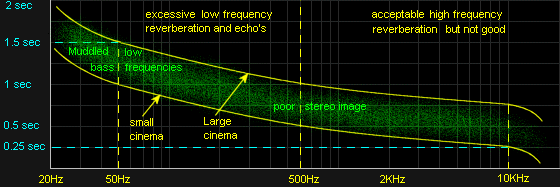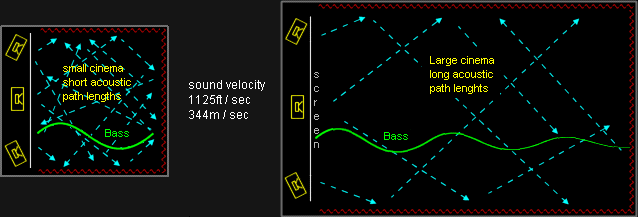Before sound systems existed, the large grand Cinemas of the past were modelled on Opera houses with an orchestra pit in front of the screen which was later replaced by an organ that came up through the floor. Opera houses evolved to make use of reverberation to increase sound level to the audience. Many composers including Mozart hated the excessive reverberation of large concert halls which restricted their music. Mozart often preferred to perform outside where the detail of the music could be heard as he intended.
The cost of increasing sound level by reverberation is at the loss of intelligibility. What evolved was an imagined ideal of correct reverberation, that is, reflective area around the opera stage of short distances (short path-lengths) opening up to larger areas of longer distances (long path-lengths).
It can be argued that specific pieces of classical music suit different characteristics of reverberation. But there is no such thing as one type of reverberation that suits all classical music and all acoustic instruments. When sound systems evolved, cinemas became trapped with the problems associated with the excessive reverberation of large auditoriums.
The subject of architecture is obsessed with status and visual form, often with little or no interest in what cannot be seen (acoustics). Many architects believe that city environment including our homes and especially auditoriums and cinemas should be as reverberant as possible. Sound absorbed is negatively described as 'room loss'. Inadequate and false understanding of acoustics has directly contributed to the excessive noise pollution of our cities.
Many early large cinemas had little or no acoustical absorption. Decorative ceilings may provide sound diffusion but little absorption. No cinema goer is interested at looking at an ornate foyer or the inside of the cinema when watching a film. The money wasted would have been better spent on properly acoustically treating the cinema.
Modern multiplexes often have red pleated curtains on walls which is mostly decorative and will absorb high frequencies, but may have little effect on absorbing low-frequencies. Often there is no acoustical absorption on ceilings except for standard acoustical tiles used in most office buildings.
George Augspurger a previous technical director of JBL and also an excellent educator, stated that the 3 Rs of acoustics are -
- Room resonance
- Early reflections
- Reverberation
audioheritage.org Profile of George Augspurger
www.artusaindustries.us/university.html Acoustic A-Z definitions
Slap echoes and Reverberation
When surround sound evolved, the Academy directive stated that the story must not be dependant on the added sound tracks. An audience attending a mono only cinema must be able to understand the story. Because excessive slap echoes and reverberation destroy intelligibility and stereo imaging, the added sound tracks have limited effect. Many films are produced with dialogue from the center speaker only, left-right and surrounds minimally used similar to the percentages shown in the below pic.

A simple hand clap at the front of the cinema will reveal the slap echoes across the walls floor and ceiling which evolve into reverberation, and will be clearly heard. As a general rule the first early reflections within 30 milli-seconds are heard as being part of the direct sound. Whereas after 30 milli-seconds the later slap echoes and reverberation are heard as being from the room.
But most often the sound from the speakers will be continuous and constantly generating slap echoes and reverberation throughout the cinema room, which becomes included within the following information from the speakers, continuing the cycle.
Regardless of those who argue that reverberation provides an agreeable aesthetic experience, it will in varying degrees mask and contaminate the new incoming sound and directly interfere with speech intelligibility, destructively changing what we are hearing from what the director intended, potentially undermining the story line of the film.
The wall curtains, seats and audience absorb sound, differently at all frequencies. The time for reverberation (at any one frequency) to diminish to -60dB (1/1,000,000) of its original energy, is called Reverberation Time (RT or T60).

The majority of modern cinemas are concrete constructed which limits sound escaping from the room. The curtain material on walls absorbs high frequencies but has little effect on absorbing low frequencies as in the pic below. If pleated curtain material absorbs 50% (-3dB) of sound energy at 500Hz the sound would have to strike the curtain 20 times to be reduced to 0.0001% (-60dB). -3dB is only heard as a slight reduction.

Compare a small and large cinema made from the same building materials, and fire a cap gun. Sound travels at approx 344m (1125ft) per second. Each time sound strikes a wall, a % is absorbed and a % is reflected, so on and so on. The average distance between walls floor and ceiling is described as 'Mean free path' or 'Mean free time'.
In a small cinema the average distance between walls is closer compared to a larger cinema. Sound will be absorbed and reflected from walls more often (in the same period of time). In a large older cinema without curtain material on walls, the hi-frequency reverberant energy will be less absorbed and appear brighter, except for air attenuation. However in a smaller modern multiplex cinema with curtain material on the walls the hi-frequencies will be readily absorbed but not the bass frequencies, therefore the reverberant bass energy will appear to be greater.

Bass frequencies have long wavelengths and due to propagation directivity, the inverse square law does not apply in a small cinema. This is similar to sub-bass in vehicles.
Due to the tradition of how cinema sound is calibrated in most multiplexes, the direct on-axis energy from the speakers is aligned to sound harsh or trebly, relying on the reverberant propagation bass energy, to fill in the difference. This traditional alignment approach is critically questioned further in this text.
In a large cinema the bass energy will have less propagation from the walls, and the inverse square law will apply to some degree. At two-thirds of the way back in a large cinema the bass energy will be less by comparison. Overall there is still insufficient absorption for low frequencies. This causes the lower end of the sound spectrum to be muddled. Action films depend on bass energy for effect, which is recent in film history, and most cinemas were designed before this trend came about.
Critical Distance
The management of acoustics for entertainment venues requires understanding Critical distance. Critical Distance is where the direct sound from the speakers and reverberant sound energies are equal. The Critical Distance is different at all frequencies. The more reverberant a room, the closer is Critical Distance. The more absorbent a room, the further is Critical Distance.

Direct sound from the speaker system diminishes in level as a function of the distance (inverse square law) whereas reverberation constantly spreads throughout the cinema room. Because there is always new sound from the speakers, reverberation keeps building up until the incoming sound, equals the sound absorbed (steady-state). At speech the direct sound energy may be equal to the reverberant, but at the lower frequencies the reverberant energy may be 4 to 10 times greater than the direct.
If reverberant energy becomes 12dB or greater than the direct sound from the speakers, toward the rear of the cinema, intelligibility becomes lost. The simplest way to find 'Critical Distance' is to play compressed pop music through the sound system. Walk around the room, and you will be surprised how easy it is to identify the critical distance.
Good acoustic design in all entertainment and cinema venues requires the Critical Distance to be as far as possible from the sound source, and any resultant reverberation minimal and even at all frequencies. Un-even reverberation imposes annoying colouration in the sound. It is understandable that 100% anechoic is not physically possible in a large public environment but the closer to achieving it the better.
This text dictates that there is no such thing as one characteristic of reverberation that suits all applications and music. Those who argue for cinema room reverberation providing an aesthetic pleasing experience are describing personal preference only related to themselves, similar to chocolate versus vanilla. The correct reverberation is the decision of film director (not the cinema) heard from an excellent sound system, especially from excellent surrounds, preferably as a horizontal line source.
Acoustical absorption
Acoustical absorption of furnishing and curtain fabrics against walls, readily absorb high frequencies, but have limited absorption at low frequencies. The further curtain fabrics are placed away from walls, the better the absorption is to include lower frequencies. The amount of sound energy absorbed depends on type of material, weight and pleating width. Rock wool (fibreglass) has the highest absorption capacity, converting molecular air movement to heat (at molecular level). Fibreglass consists of minute razor sharp fibres that are irritant and need to be contained within fabric.

The 1/4 wave-length rule. Acoustically absorbent material must be placed away from walls and ceiling, at a distance of 1/4 wavelength of the lowest frequency to be absorbed. This will include all higher frequencies if the absorbent material is soft furnishing or fibreglass. Please note that the ceiling should also be included.
Understandably, placing acoustical absorbent material 2m (6ft) from all walls may be thought of as impractical but the closer to achieving it the better. The slight reduction in the visual size of the cinema, will only be noticed when the lights are on. Acoustically the cinema will sound and feel LARGER. Also an acoustic absorbent environment is relaxing and calming and greatly enhances the enjoyment of the film.
 Pirates. A film of a pirate ship on the open seas is in contradiction to the echoes and reverberation we are hearing from the cinema. Visually this is similar to putting mirrors on cinema walls, or watching a film with the lights on.
Pirates. A film of a pirate ship on the open seas is in contradiction to the echoes and reverberation we are hearing from the cinema. Visually this is similar to putting mirrors on cinema walls, or watching a film with the lights on.
Only if the cinema approaches being anechoic at all frequencies does the auditory experience of being on the open seas with the pirates appear real. The pirates are caught and locked in a cell. The recorded reverberation of the cell should be heard from the surround speakers only. This gives us a feeling of being in the cell with the pirates trying to escape.
The human mind evolved to un-consciously obtain intelligence from direct sound, by psychologically separating the reverberant sound to give us an accurate acoustical sense of distance and the size of a cave or room. The open ocean, forest or field, give little or zero reverberation or echo.
www.acoustics.salford.ac.ukAnechoic myth There is a myth that being in a 100% anechoic environment is an emotionally negative experience. This myth needs to be well and truly busted. The myth possibly originated from experiments on university students during the 1950s, who were locked in a tiny anechoic test chamber, to represent being buried alive in a small airless coffin, with no possibility of escape, to find out how they would emotionally react.
Social experiments have proved that when living in a noise polluted city, to be able to find solace in a silent softly furnished acoustic absorbent environment, with free access to come and go as we please; all of us, that is, everyone without exception, relaxes letting go of anxiety and stressful thoughts.
When the lights are dimmed with beautiful music 'particularly classical' the experience becomes almost magical. The most wonderful enhancement before any film is a prologue of the music for approx 5 minutes. If only cinema management fully understood this, what a magical experience going to the movies would be.
 Any cinema can be simply made to be close to anechoic at low cost, by simply approaching the solution in small steps. Fibreglass or Rockwool is in-expensive and can be placed into open low weight frames. There is possibly nothing else that will work as well, except asbestos. The fibreglass or Rockwool needs to be contained in fabric that stops irritant fibres getting loose. Polyester fibre has some acoustic absorption at high-frequencies but is ineffective at low frequencies, so don't use it.
Any cinema can be simply made to be close to anechoic at low cost, by simply approaching the solution in small steps. Fibreglass or Rockwool is in-expensive and can be placed into open low weight frames. There is possibly nothing else that will work as well, except asbestos. The fibreglass or Rockwool needs to be contained in fabric that stops irritant fibres getting loose. Polyester fibre has some acoustic absorption at high-frequencies but is ineffective at low frequencies, so don't use it.
The containing fabric should have to have its own fire retardant specification to comply with public building approvals. The installation procedure can be done all at once, or spread out over time in small steps so not to interfere with session times. Check that the installed procedure is compliant with correct fire and building regulations, including insurance.
'C' weighting is the flat acoustic measurement response applied to sound systems and entertainment venues including cinemas and recording studios. 'A' weighting measurement is for environmental and industrial noise measurement and includes building materials. 'A' weighting is not a flat response measurement because it is insensitive to bass frequencies, similar to our hearing at a low loudness level.
'A' weighting All building materials are quoted in 'A' weighting measurement and therefore these measurements cannot be used in reference to bass frequency acoustical absorption and transmission reduction when applied to cinemas and entertainment venues. However it is simple to do cross calculations to the 'C' weighting measurement to obtain a flat frequency response reference to include the lower frequencies.
Many companies that supply acoustic absorbent material that complies with fire regulations will advise correctly. Excellent information is available on their sites.
www.rockwool.com
www.ecophon.com
www.acoustilog.com
www.acousticalsurfaces.com
Many architectural companies that specialise in acoustics do exceptionally good work and need to be commended. But there are also questionable companies that market themselves as acoustic specialists. Many entertainment venues and cinemas have been caught out by building approvals that were for the 'A' weighting measurement only, and were later closed down because of excessive bass noise leakage.
Questionable practices The worst practices are from kickbacks made from specifying expensive materials falsely described as absorbent that may be polyester fibre or a grey hardened variation of it. A 1.2m x 1.8m (4ft x 6ft) sheet, or its equivalent size in large rolls may be approx $5 from the importer, but when sold through high mark-up distributors that re-label the material it can be on-sold for x10 approx of its original price with a high % kickback to the specifying expert.
Acoustics is not rocket science, and there is not one thing about the subject that can not be explained to a primary school child. Things to be suspicious of.
- Telling you something you can not understand.
- Doing expensive analysis with elaborate test equipment.
- Discounting the 1/4 wavelength rule.
- Insists on using absorbent material that looks like polyester fibre.
- Not willing to volunteer demonstration against fibreglass or Rockwool.
- Smooth sales talk, bragging and name dropping.
- Representing a logo of a licensing company with a large yearly fee.
Repeat Do not accept any material as being acoustically absorbent sold by a so called expert or specification sheet, unless it has been proved to be so. Always insist on a direct comparison to Rockwool or fibreglass, by simply holding it up to your ear and doing an A B check.


